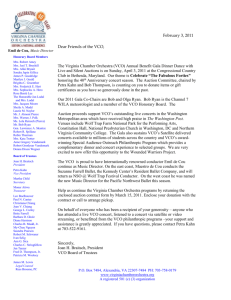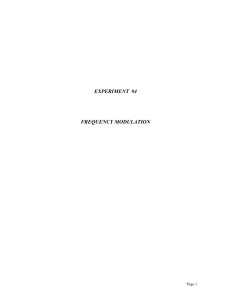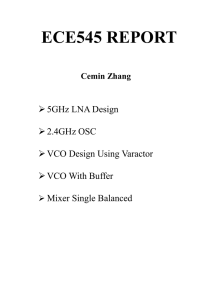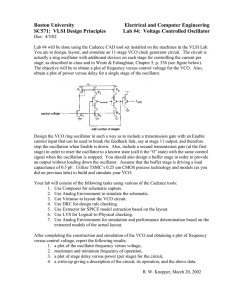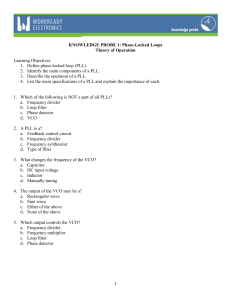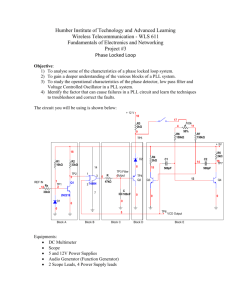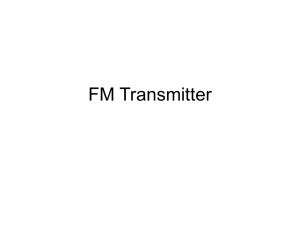AN-860 APPLICATION NOTE
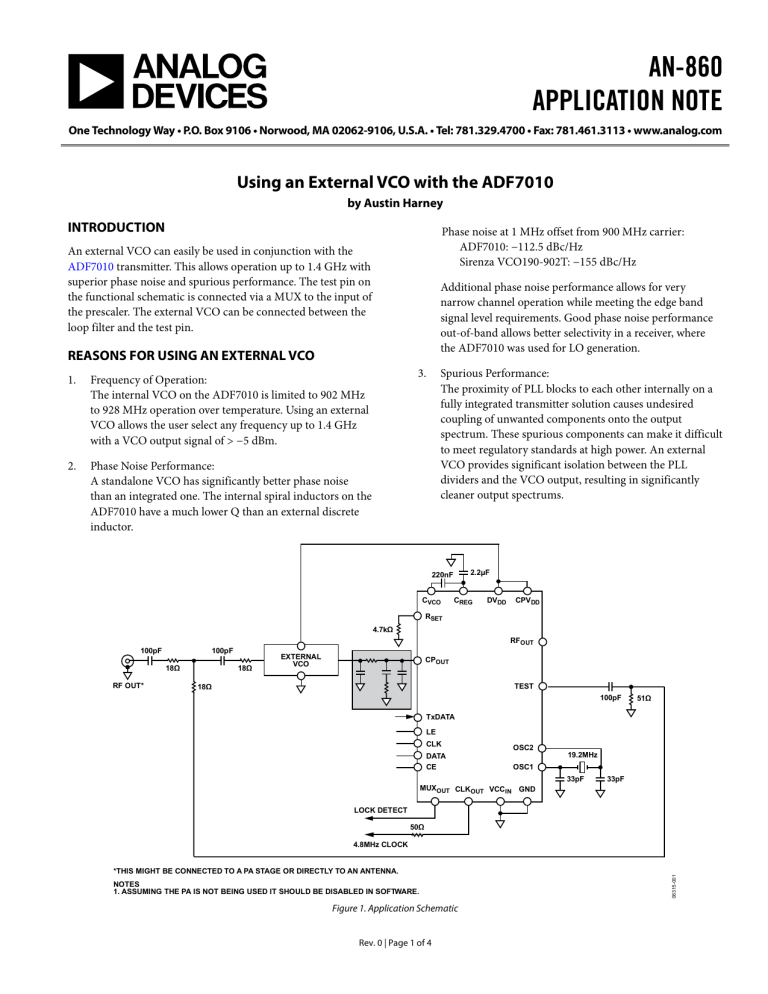
AN-860
APPLICATION NOTE
One Technology Way • P.O.
Box 9106 • Norwood, MA 02062-9106, U.S.A.
• Tel: 781.329.4700
• Fax: 781.461.3113
• www.analog.com
Using an External VCO with the ADF7010
by Austin Harney
INTRODUCTION
An external VCO can easily be used in conjunction with the
ADF7010 transmitter. This allows operation up to 1.4 GHz with superior phase noise and spurious performance. The test pin on the functional schematic is connected via a MUX to the input of the prescaler. The external VCO can be connected between the loop filter and the test pin.
Phase noise at 1 MHz offset from 900 MHz carrier:
ADF7010: −112.5 dBc/Hz
Sirenza VCO190-902T: −155 dBc/Hz
Additional phase noise performance allows for very narrow channel operation while meeting the edge band signal level requirements. Good phase noise performance out-of-band allows better selectivity in a receiver, where the ADF7010 was used for LO generation.
REASONS FOR USING AN EXTERNAL VCO
1.
Frequency of Operation:
The internal VCO on the ADF7010 is limited to 902 MHz to 928 MHz operation over temperature. Using an external
VCO allows the user select any frequency up to 1.4 GHz with a VCO output signal of > −5 dBm.
2.
Phase Noise Performance:
A standalone VCO has significantly better phase noise than an integrated one. The internal spiral inductors on the
ADF7010 have a much lower Q than an external discrete inductor.
3.
Spurious Performance:
The proximity of PLL blocks to each other internally on a fully integrated transmitter solution causes undesired coupling of unwanted components onto the output spectrum. These spurious components can make it difficult to meet regulatory standards at high power. An external
VCO provides significant isolation between the PLL dividers and the VCO output, resulting in significantly cleaner output spectrums.
100pF
18 Ω
RF OUT* 18 Ω
100pF
18 Ω
EXTERNAL
VCO
4.7k
Ω
220nF 2.2µF
C
VCO
R
SET
C
REG
DV
DD
CPV
DD
RF
OUT
CP
OUT
TEST
TxDATA
LE
CLK
DATA
CE
OSC2
OSC1
MUX
OUT
CLK
OUT
VCC
IN
GND
LOCK DETECT
4.8MHz CLOCK
50 Ω
*THIS MIGHT BE CONNECTED TO A PA STAGE OR DIRECTLY TO AN ANTENNA.
NOTES
1. ASSUMING THE PA IS NOT BEING USED IT SHOULD BE DISABLED IN SOFTWARE.
Figure 1. Application Schematic
Rev. 0 | Page 1 of 4
100pF 51 Ω
19.2MHz
33pF 33pF
AN-860
APPLICATION INFORMATION
The external VCO is connected following the loop filter and before the test pin. ADIsimPLL™ is an invaluable tool in the design and simulation of these loop filters.
The 18 Ω/100 pF combination is designed to split the VCO output RF power equally between the system output and the test pin. By altering the resistor/capacitor combination more or less power can be fed back to the N-divider. Feeding extra power back to the test pin can allow the PLL to lock to higher frequencies, and give greater margin in terms of the minimum input signal. Care should be taken so as not to feed >5 dBm output power into the test pin, as this reduces the effective range of the N-dividers.
In software, the external VCO mode is enabled by simply powering down the internal VCO.
The internal PA can be used with an external VCO; however, it does cause significantly higher spurious. A cheap external discrete PA stage is more effective at amplifying the VCO output power.
DESIGNING LOOP FILTERS TO USE WITH AN
EXTERNAL VCO
ADIsimPLL can be downloaded for free from the ADI PLL Web page. To design and simulate a loop filter for the ADF7010 with external VCO, you should follow the following procedure.
1.
<screen 1> Select the option “PLL should produce a range of output frequencies.”
2.
“Specify the PFD frequency” option should be checked.
3.
<screen2> Input the frequencies required and the PFD you wish to use. The maximum PFD frequency is the crystal frequency, and results in the best phase noise. Spurious components are a few dB higher for a higher PFD.
4.
<screen 3> Select the ADF4153 as the PLL to use. The
ADF7011 is not available yet in this mode.
5.
<screen5> Enter required VCO parameters, based on
VCO module parameters.
6.
<screen7> Hit the next button and select the loop filter as shown in applications diagram. (3-pole integrator).
7.
Once the <finish> button has been pressed, under
CHIP > PFD, change the R
SET
resistor to 2.5 kΩ and select a charge pump current of 2.02 mA. Note that the level of phase noise is 8 dB worse on the ADF7010/ADF7011 compared to the ADF4153. All other measurements including lock time, and loop filter BW are accurate.
Rev. 0 | Page 2 of 4
PERFORMANCE PLOTS
5
0
–5
LOW V
REG
LOW V
REG
LOW V
REG
MED V
REG
HIGH V
REG
, –40°C
, +25°C
, +85°C
, +25°C
, +25°C
–10
–15
–20
–25
–30
200 700 1200
FREQUENCY (MHz)
Figure 2. N-Divider (Input Sensitivity)
1700
–5
–10
–15
–20
–25
–30
–35
–40
–45
–50
–55
–60
–65
–70
–75
–80
800
100MHz SPAN
VCO = SIRENZA VCO190-902T
VCO OUTPUT = 900MHz
PFD = 19.2MHz
LOOP BW = 100kHz
SPUR AT +57.6MHz
825 850 875 900 925
FREQUENCY (MHz)
Figure 3. Output Spectrum
950 975 1000
AN-860
–80
–85
–90
–95
–100
–105
–110
–115
–120
REF
–125
–130
–135
<10MHz OFFSET FROM CARRIER
VCO = SIRENZA VCO190-902T
VCO OUTPUT = 900MHz
–140
–145
1k
PFD = 19.2MHz
LOOP BW = 100kHz
10k 100k
FREQUENCY (Hz)
1M
Figure 4. Phase Noise Performance
10M
–60
–80
–100
0
–20
–40
100MHz SPAN
VCO = SIRENZA VCO190-902T
VCO OUTPUT = 900MHz
PFD = 19.2MHz
LOOP BW = 100kHz
–120
895 900 905 910 915 920 925
VCO OUTPUT FREQUENCY (Hz)
Figure 5. Spurious Response
930 935
Rev. 0 | Page 3 of 4
AN-860
APPLICATION GUIDELINES
LAYOUT TIPS WHEN USING AN EXTERNAL VCO
•
Ensure that tracks from charge pump to VCO input are kept short. The tracks from the VCO output to the test pin should be kept as short as possible.
•
A 22 μF capacitor and a 10 pF capacitor should be used to decouple the supplies of the VCO. These capacitors should be kept as close as possible to the VCO.
•
All supplies of the ADF7010 should be decoupled with
100 nF and 10 pF capacitors. These capacitors should be as close to the supply pins as possible.
ADDITIONAL GUIDELINES
•
The mode to enable the external VCO is selected by disabling the internal VCO. The PA should also be turned off in software.
•
Examine the sensitivity plot in Figure 2. The minimum
input power as per the plot should have at least 3 dB of margin, to ensure reliable N-divider performance over all supplies and temperatures.
•
Beatnote spurious are elements of the nearest integer channel coupling onto the RF output. This is an integral part of any fractional-N design. The spurious levels are attenuated by the loop filter, so having a low filter BW reduces these. Avoid operating on an integer channel. Careful crystal selection reduces the levels to the point where it is swamped by the modulation.
•
Beatnote spurious level can be traded off against phase noise using the fastlock mode in the software. This activates a bleed current, which linearizes the charge pump.
•
There will be a spur at VCO/2. This is a prescaler spur and is typically <−70 dBc.
©2006 Analog Devices, Inc. All rights reserved. Trademarks and
registered trademarks are the property of their respective owners.
AN06315-0-9/06(0)
Rev. 0 | Page 4 of 4
TTT

